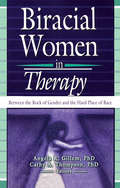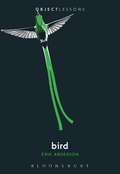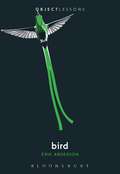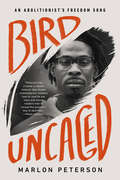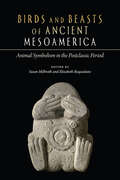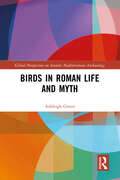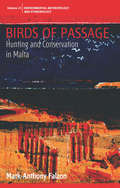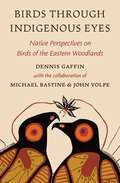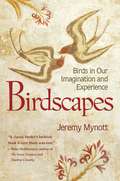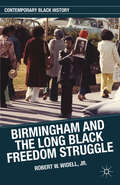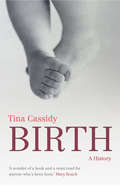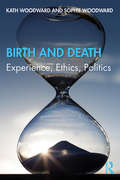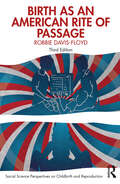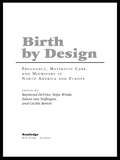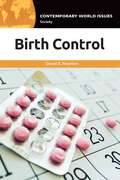- Table View
- List View
Biracial Women in Therapy: Between the Rock of Gender and the Hard Place of Race
by Cathy Thompson Angela R GillemGet a unique perspective on the female biracial experience! Biracial Women in Therapy: Between the Rock of Gender and the Hard Place of Race examines how physical appearance, cultural knowledge, and cultural stereotypes affect the experience of mixed-race women in belonging to, and being accepted within, their cultures. This unique book combines empirical research, theoretical papers, and first-person narrative to address issues relevant to providing therapy to biracial women and girls, helping therapists and counselors develop a treatment framework based on sociocultural factors. Researchers, practitioners, and academics provide insight into the biracial reality, taking multiple aspects of clients' lives into account rather than looking for simple hierarchies of well-being based on race. Biracial Women in Therapy is a building block for mental health practitioners in the construction of theory and practice in working with biracial females. The book examines how a biracial women's racial/ethnic identity intersects with her gender and sexual identity to affect her sense of belonging and acceptance, addressing issues of appearance, social class, disability, power and guilt, and dating and marriage. Topics addressed in the book include: the complexities of multiple minority status how ethnic differences affect biracial adolescents issues encountered by biracial women from a sociohistorical context biracial women's attitudes toward counseling stereotypes of marginalization and identity confusion a multicultural feminist approach to counseling and a first-person narrative of one author's racial and sexual identity development Biracial Women in Therapy: Between the Rock of Gender and the Hard Place of Race is a one-of-a-kind resource for counselors, therapists, researchers, and academics seeking insight into unique issues of mixed-race women.
Biracial Women in Therapy: Between the Rock of Gender and the Hard Place of Race
by Cathy Thompson Angela R GillemGet a unique perspective on the female biracial experience! Biracial Women in Therapy: Between the Rock of Gender and the Hard Place of Race examines how physical appearance, cultural knowledge, and cultural stereotypes affect the experience of mixed-race women in belonging to, and being accepted within, their cultures. This unique book combines empirical research, theoretical papers, and first-person narrative to address issues relevant to providing therapy to biracial women and girls, helping therapists and counselors develop a treatment framework based on sociocultural factors. Researchers, practitioners, and academics provide insight into the biracial reality, taking multiple aspects of clients' lives into account rather than looking for simple hierarchies of well-being based on race. Biracial Women in Therapy is a building block for mental health practitioners in the construction of theory and practice in working with biracial females. The book examines how a biracial women's racial/ethnic identity intersects with her gender and sexual identity to affect her sense of belonging and acceptance, addressing issues of appearance, social class, disability, power and guilt, and dating and marriage. Topics addressed in the book include: the complexities of multiple minority status how ethnic differences affect biracial adolescents issues encountered by biracial women from a sociohistorical context biracial women's attitudes toward counseling stereotypes of marginalization and identity confusion a multicultural feminist approach to counseling and a first-person narrative of one author's racial and sexual identity development Biracial Women in Therapy: Between the Rock of Gender and the Hard Place of Race is a one-of-a-kind resource for counselors, therapists, researchers, and academics seeking insight into unique issues of mixed-race women.
Bird (Object Lessons)
by Erik AndersonObject Lessons is a series of short, beautifully designed books about the hidden lives of ordinary things. Hope, as Emily Dickinson famously wrote, is the thing with feathers. Erik Anderson, on the other hand, regards our obsession with birds as too sentimental, too precious. Birds don't express hope. They express themselves. But this tension between the versions of nature that lodge in our minds and the realities that surround us is the central theme of Bird. This is no field guide. It's something far more unusual and idiosyncratic, balancing science with story, anatomy with metaphor, habitat with history. Anderson illuminates the dark underbelly of our bird fetish and offers a fresh, alternative vision of one of nature's most beloved objects.Object Lessons is published in partnership with an essay series in the The Atlantic.
Bird (Object Lessons)
by Erik AndersonObject Lessons is a series of short, beautifully designed books about the hidden lives of ordinary things. Hope, as Emily Dickinson famously wrote, is the thing with feathers. Erik Anderson, on the other hand, regards our obsession with birds as too sentimental, too precious. Birds don't express hope. They express themselves. But this tension between the versions of nature that lodge in our minds and the realities that surround us is the central theme of Bird. This is no field guide. It's something far more unusual and idiosyncratic, balancing science with story, anatomy with metaphor, habitat with history. Anderson illuminates the dark underbelly of our bird fetish and offers a fresh, alternative vision of one of nature's most beloved objects.Object Lessons is published in partnership with an essay series in the The Atlantic.
Bird Uncaged: An Abolitionist's Freedom Song
by Marlon PetersonFrom a leading prison abolitionist, a moving memoir about coming of age in Brooklyn and surviving incarceration—and a call to break free from all the cages that confine us. Marlon Peterson grew up in 1980s Crown Heights, raised by Trinidadian immigrants. Amid the routine violence that shaped his neighborhood, Marlon became a high-achieving and devout child, the specter of the American dream opening up before him. But in the aftermath of immense trauma, he participated in a robbery that resulted in two murders. At nineteen, Peterson was charged and later convicted. He served ten long years in prison. While incarcerated, Peterson immersed himself in anti-violence activism, education, and prison abolition work. In Bird Uncaged, Peterson challenges the typical &“redemption&” narrative and our assumptions about justice. With vulnerability and insight, he uncovers the many cages—from the daily violence and trauma of poverty, to policing, to enforced masculinity, and the brutality of incarceration—created and maintained by American society.Bird Uncaged is a twenty-first-century abolitionist memoir, and a powerful debut that demands a shift from punishment to healing, an end to prisons, and a new vision of justice.
Birds and Beasts of Ancient Mesoamerica: Animal Symbolism in the Postclassic Period
by Susan Milbrath Elizabeth BaquedanoBirds and Beasts of Ancient Mesoamerica links Precolumbian animal imagery with scientific data related to animal morphology and behavior, providing in-depth studies of the symbolic importance of animals and birds in Postclassic period Mesoamerica. Representations of animal deities in Mesoamerica can be traced back at least to Middle Preclassic Olmec murals, stone carvings, and portable art such as lapidary work and ceramics. Throughout the history of Mesoamerica real animals were merged with fantastical creatures, creating zoological oddities not unlike medieval European bestiaries. According to Spanish chroniclers, the Aztec emperor was known to keep exotic animals in royal aviaries and zoos. The Postclassic period was characterized by an iconography that was shared from central Mexico to the Yucatan peninsula and south to Belize. In addition to highlighting the symbolic importance of nonhuman creatures in general, the volume focuses on the importance of the calendrical and astronomical symbolism associated with animals and birds. Inspired by and dedicated to the work of Mesoamerican scholar Cecelia Klein and featuring imagery from painted books, monumental sculpture, portable arts, and archaeological evidence from the field of zooarchaeology, Birds and Beasts of Ancient Mesoamerica highlights the significance of the animal world in Postclassic and early colonial Mesoamerica. It will be important to students and scholars studying Mesoamerican art history, archaeology, ethnohistory, and zoology.
Birds in Roman Life and Myth (Global Perspectives on Ancient Mediterranean Archaeology)
by Ashleigh GreenThis book explores the place of birds in Roman myth and everyday life, focusing primarily on the transitional period of 100 BCE to 100 CE within the Italian peninsula. A diverse range of topics is considered in order to build a broad overview of the subject. Beginning with an appraisal of omens, augury, and auspices – including the ‘sacred chickens’ consulted by generals before battle – it goes on to examine how Romans farmed birds, hunted them, and kept them as pets. It demonstrates how the ownership and consumption of birds were used to communicate status and prestige, and how bird consumption mirrored wider economic and social trends. Each topic adopts an interdisciplinary approach, considering literary evidence alongside art, material culture, zooarchaeology, and modern ornithological knowledge. The inclusion of zooarchaeology adds another dimension to the work and highlights the value of using animals and faunal remains to interpret the past. Studying the Roman view of birds offers great insight into how they conceived of their relationship with the gods and how they stratified and organised their society. This book is a valuable resource for bird lovers and researchers alike, particularly those studying animals in the ancient world.
Birds in Roman Life and Myth (Global Perspectives on Ancient Mediterranean Archaeology)
by Ashleigh GreenThis book explores the place of birds in Roman myth and everyday life, focusing primarily on the transitional period of 100 BCE to 100 CE within the Italian peninsula. A diverse range of topics is considered in order to build a broad overview of the subject. Beginning with an appraisal of omens, augury, and auspices – including the ‘sacred chickens’ consulted by generals before battle – it goes on to examine how Romans farmed birds, hunted them, and kept them as pets. It demonstrates how the ownership and consumption of birds were used to communicate status and prestige, and how bird consumption mirrored wider economic and social trends. Each topic adopts an interdisciplinary approach, considering literary evidence alongside art, material culture, zooarchaeology, and modern ornithological knowledge. The inclusion of zooarchaeology adds another dimension to the work and highlights the value of using animals and faunal remains to interpret the past. Studying the Roman view of birds offers great insight into how they conceived of their relationship with the gods and how they stratified and organised their society. This book is a valuable resource for bird lovers and researchers alike, particularly those studying animals in the ancient world.
Birds of Passage: Hunting and Conservation in Malta (Environmental Anthropology and Ethnobiology #25)
by Mark-Anthony FalzonBird migration between Europe and Africa is a fraught journey, particularly in the Mediterranean, where migratory birds are shot and trapped in large numbers. In Malta, thousands of hunters share a shrinking countryside. They also rub shoulders with a strong bird-protection and conservation lobby. Drawing on years of ethnographic fieldwork, this book traces the complex interactions between hunters, birds and the landscapes they inhabit, as well as the dynamics and politics of bird conservation. Birds of Passage looks at the practice and meaning of hunting in a specific context, and raises broader questions about human-wildlife interactions and the uncertain outcomes of conservation.
Birds of Passage: Hunting and Conservation in Malta (Environmental Anthropology and Ethnobiology #25)
by Mark-Anthony FalzonBird migration between Europe and Africa is a fraught journey, particularly in the Mediterranean, where migratory birds are shot and trapped in large numbers. In Malta, thousands of hunters share a shrinking countryside. They also rub shoulders with a strong bird-protection and conservation lobby. Drawing on years of ethnographic fieldwork, this book traces the complex interactions between hunters, birds and the landscapes they inhabit, as well as the dynamics and politics of bird conservation. Birds of Passage looks at the practice and meaning of hunting in a specific context, and raises broader questions about human-wildlife interactions and the uncertain outcomes of conservation.
Birds of Passage: Hunting and Conservation in Malta (Environmental Anthropology and Ethnobiology #25)
by Mark-Anthony FalzonBird migration between Europe and Africa is a fraught journey, particularly in the Mediterranean, where migratory birds are shot and trapped in large numbers. In Malta, thousands of hunters share a shrinking countryside. They also rub shoulders with a strong bird-protection and conservation lobby. Drawing on years of ethnographic fieldwork, this book traces the complex interactions between hunters, birds and the landscapes they inhabit, as well as the dynamics and politics of bird conservation. Birds of Passage looks at the practice and meaning of hunting in a specific context, and raises broader questions about human-wildlife interactions and the uncertain outcomes of conservation.
Birds of Passage: Hunting and Conservation in Malta (Environmental Anthropology and Ethnobiology #25)
by Mark-Anthony FalzonBird migration between Europe and Africa is a fraught journey, particularly in the Mediterranean, where migratory birds are shot and trapped in large numbers. In Malta, thousands of hunters share a shrinking countryside. They also rub shoulders with a strong bird-protection and conservation lobby. Drawing on years of ethnographic fieldwork, this book traces the complex interactions between hunters, birds and the landscapes they inhabit, as well as the dynamics and politics of bird conservation. Birds of Passage looks at the practice and meaning of hunting in a specific context, and raises broader questions about human-wildlife interactions and the uncertain outcomes of conservation.
Birds through Indigenous Eyes: Native Perspectives on Birds of the Eastern Woodlands
by Dennis GaffinAn intimate and personal account of the profound roles birds play in the lives of some Indigenous peopleFor many hours over a period of years, white anthropologist Dennis Gaffin and two Indigenous friends, Michael Bastine and John Volpe, recorded their conversations about a shared passion: the birds of upstate New York and southern Ontario. In these lively, informal talks, Bastine (a healer and naturalist of Algonquin descent) and Volpe (a naturalist and animal rehabilitator of Ojibwe and Métis descent) shared their experiences of, and beliefs about, birds, describing the profound spiritual, psychological, and social roles of birds in the lives of some Indigenous people. Birds through Indigenous Eyes presents highlights of these conversations, placing them in context and showing how Native understandings of birds contrast with conventional Western views.Bastine and Volpe bring to life Algonquin, Ojibwe, and Haudenosaunee (Iroquois) beliefs about birds. They reveal how specific birds and bird species are seamlessly integrated into spirituality and everyday thought and action, how birds bring important messages to individual people, how a bird species can become associated with a person, and how birds provide warnings about our endangered environment. Over the course of the book, birds such as the house sparrow, Eastern phoebe, Northern flicker, belted kingfisher, gray catbird, cedar waxwing, and black-capped chickadee are shown in a new light—as spiritual and practical helpers that can teach humans how to live well.An original work of ethno-ornithology that offers a rare close-up look at some Native views on birds, Birds through Indigenous Eyes opens rich new perspectives on the deep connections between birds and humans.
Birds through Indigenous Eyes: Native Perspectives on Birds of the Eastern Woodlands
by Dennis GaffinAn intimate and personal account of the profound roles birds play in the lives of some Indigenous peopleFor many hours over a period of years, white anthropologist Dennis Gaffin and two Indigenous friends, Michael Bastine and John Volpe, recorded their conversations about a shared passion: the birds of upstate New York and southern Ontario. In these lively, informal talks, Bastine (a healer and naturalist of Algonquin descent) and Volpe (a naturalist and animal rehabilitator of Ojibwe and Métis descent) shared their experiences of, and beliefs about, birds, describing the profound spiritual, psychological, and social roles of birds in the lives of some Indigenous people. Birds through Indigenous Eyes presents highlights of these conversations, placing them in context and showing how Native understandings of birds contrast with conventional Western views.Bastine and Volpe bring to life Algonquin, Ojibwe, and Haudenosaunee (Iroquois) beliefs about birds. They reveal how specific birds and bird species are seamlessly integrated into spirituality and everyday thought and action, how birds bring important messages to individual people, how a bird species can become associated with a person, and how birds provide warnings about our endangered environment. Over the course of the book, birds such as the house sparrow, Eastern phoebe, Northern flicker, belted kingfisher, gray catbird, cedar waxwing, and black-capped chickadee are shown in a new light—as spiritual and practical helpers that can teach humans how to live well.An original work of ethno-ornithology that offers a rare close-up look at some Native views on birds, Birds through Indigenous Eyes opens rich new perspectives on the deep connections between birds and humans.
Birdscapes: Birds in Our Imagination and Experience (Princeton Shorts Ser.)
by Jeremy MynottWhat draws us to the beauty of a peacock, the flight of an eagle, or the song of a nightingale? Why are birds so significant in our lives and our sense of the world? And what do our ways of thinking about and experiencing birds tell us about ourselves? Birdscapes is a unique meditation on the variety of human responses to birds, from antiquity to today, and from casual observers to the globe-trotting "twitchers" who sometimes risk life, limb, and marriages simply to add new species to their "life lists." Drawing extensively on literature, history, philosophy, and science, Jeremy Mynott puts his own experiences as a birdwatcher in a rich cultural context. His sources range from the familiar--Thoreau, Keats, Darwin, and Audubon--to the unexpected--Benjamin Franklin, Giacomo Puccini, Oscar Wilde, and Monty Python. Just as unusual are the extensive illustrations, which explore our perceptions and representations of birds through images such as national emblems, women's hats, professional sports logos, and a Christmas biscuit tin, as well as classics of bird art. Each chapter takes up a new theme--from rarity, beauty, and sound to conservation, naming, and symbolism--and is set in a new place, as Mynott travels from his "home patch" in Suffolk, England, to his "away patch" in New York City's Central Park, as well as to Russia, Australia, and Greece. Conversational, playful, and witty, Birdscapes gently leads us to reflect on large questions about our relation to birds and the natural world. It encourages birders to see their pursuits in a broader human context--and it shows nonbirders what they may be missing.
Birmingham and the Long Black Freedom Struggle (Contemporary Black History)
by Robert W. Widell, Jr.Birmingham, Alabama looms large in the history of the twentieth-century black freedom struggle, but to date historians have mostly neglected the years after 1963. Here, author Robert Widell explores the evolution of Birmingham black activism into the 1970s, providing a valuable local perspective on the "long" black freedom struggle.
Birth: A History
by Tina CassidyThe engaging and eye-opening story of how we and our ancestors entered the world.Through the frigid, blurry January weeks after George was born, I found myself suddenly housebound with time to ruminate - though not time to cook or take a shower. When George was peaceful, my mind returned to that nagging question: why is birth so hit and miss after all this time? I needed to put into perspective my own experience. I needed to know what other women, in other cultures, in other times had done.Birth is a book that will open the eyes of even the most informed experts on the subject. Cassidy looks at every aspect of childbirth - from fathers and mothers to doctors and widwives across the centuries - with admirable objectivity in a work that is utterly gripping, occasionally shocking and essential reading for the human race.
Birth and Death: Experience, Ethics, Politics
by Kath Woodward Sophie WoodwardUsually conceived in opposition to each other – birth as a hopeful beginning, death as an ending – this book brings them into dialogue with each other to argue that both are central to our experiences of being in the world and part of living. Written by two authors, this book takes an intergenerational approach to highlight the connections and disconnections between birth and death; adopting a relational approach allows the book to explore birth and death through the key relationships that constitute them: personal and social, private and public, the affective and social norms, the actual and the virtual and the ordinary and profound. Of interest to academics and students in the fields of feminism, phenomenology and the life course, the book will also be of relevance to policy makers in the areas of birth activism and end of life care. Drawing from personal stories, everyday life and publicly contested examples, the book will also be of interest to a more general readership as it engages with questions we all at some point will grapple with.
Birth and Death: Experience, Ethics, Politics
by Kath Woodward Sophie WoodwardUsually conceived in opposition to each other – birth as a hopeful beginning, death as an ending – this book brings them into dialogue with each other to argue that both are central to our experiences of being in the world and part of living. Written by two authors, this book takes an intergenerational approach to highlight the connections and disconnections between birth and death; adopting a relational approach allows the book to explore birth and death through the key relationships that constitute them: personal and social, private and public, the affective and social norms, the actual and the virtual and the ordinary and profound. Of interest to academics and students in the fields of feminism, phenomenology and the life course, the book will also be of relevance to policy makers in the areas of birth activism and end of life care. Drawing from personal stories, everyday life and publicly contested examples, the book will also be of interest to a more general readership as it engages with questions we all at some point will grapple with.
Birth as an American Rite of Passage (Social Science Perspectives on Childbirth and Reproduction)
by Robbie Davis-FloydThis classic book, first published in 1992 and again in 2003, has inspired three generations of childbearing people, birth activists and researchers, and birth practitioners—midwives, doulas, nurses, and obstetricians—to take a fresh look at the "standard procedures" that are routinely used to "manage" American childbirth. It was the first book to identify these non-evidence-based obstetric interventions as rituals that enact and transmit the core values of the American technocracy, thereby answering the pressing question of why these interventions continue to be performed despite all evidence to the contrary. This third edition brings together Davis-Floyd's insights into the intense ritualization of labor and birth and the technocratic, humanistic, and holistic models of birth with new data collected in recent years.
Birth as an American Rite of Passage (Social Science Perspectives on Childbirth and Reproduction)
by Robbie Davis-FloydThis classic book, first published in 1992 and again in 2003, has inspired three generations of childbearing people, birth activists and researchers, and birth practitioners—midwives, doulas, nurses, and obstetricians—to take a fresh look at the "standard procedures" that are routinely used to "manage" American childbirth. It was the first book to identify these non-evidence-based obstetric interventions as rituals that enact and transmit the core values of the American technocracy, thereby answering the pressing question of why these interventions continue to be performed despite all evidence to the contrary. This third edition brings together Davis-Floyd's insights into the intense ritualization of labor and birth and the technocratic, humanistic, and holistic models of birth with new data collected in recent years.
Birth By Design: Pregnancy, Maternity Care and Midwifery in North America and Europe
by Raymond DeVries Sirpa Wrede Edwin Van Teijlingen Cecilia BenoitFirst published in 2001. Routledge is an imprint of Taylor & Francis, an informa company.
Birth By Design: Pregnancy, Maternity Care and Midwifery in North America and Europe
by Raymond De Vries Cecilia Benoit Edwin Van Teijlingen Sirpa WredeFirst published in 2001. Routledge is an imprint of Taylor & Francis, an informa company.
Birth Control: A Reference Handbook (Contemporary World Issues)
by David E. NewtonBirth Control: A Reference Handbook provides a breadth and depth of discussion about birth control throughout human history and in the modern day, with attention paid to the controversies related to it.Birth Control: A Reference Handbook covers the topic of birth control from the earliest pages of human history to the present day. The book is divided into two parts. The first two chapters provide a historical background to the topic and a review of current issues and problems. The remainder of the book consists of chapters that aid the reader in continuing her or his own research on the topic, such as an extended annotated bibliography, chronology, glossary, noteworthy individuals and organizations in the field, and important data and documents.This book differs from other works on its subject primarily because of the variety of resources provided, such as further reading, perspective essays on the topic, a historical timeline, and useful terms in the field. It is intended for readers of high school through the community college level, along with adult readers who may be interested in the topic.
Birth Control: A Reference Handbook (Contemporary World Issues)
by David E. NewtonBirth Control: A Reference Handbook provides a breadth and depth of discussion about birth control throughout human history and in the modern day, with attention paid to the controversies related to it.Birth Control: A Reference Handbook covers the topic of birth control from the earliest pages of human history to the present day. The book is divided into two parts. The first two chapters provide a historical background to the topic and a review of current issues and problems. The remainder of the book consists of chapters that aid the reader in continuing her or his own research on the topic, such as an extended annotated bibliography, chronology, glossary, noteworthy individuals and organizations in the field, and important data and documents.This book differs from other works on its subject primarily because of the variety of resources provided, such as further reading, perspective essays on the topic, a historical timeline, and useful terms in the field. It is intended for readers of high school through the community college level, along with adult readers who may be interested in the topic.
